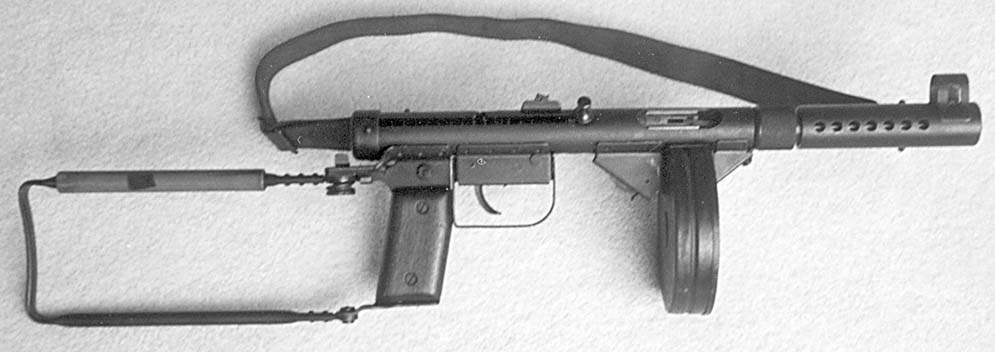
By J.R. Moody
The history of World War II and the aftermath of war torn Europe plays an important part in the development of the Danish Hovea M/49 sub-machine gun. Until 1945, Denmark had been occupied by the Nazis, therefore no indigenous weapons designs or manufacture were forthcoming. Thus, after the war, Denmark needed to rearm. The period of the late 40’s through the 60’s was a heyday for sub-machine guns in most armies of the world, since this handy weapon proved its usefulness with all nations soldiering in the war.
Sweden had been busy immediately after the war developing competing designs for the country’s next generation sub-machine gun. Two companies designed their version, using the Swedish government guidelines which stressed the requirements needed in the next Swedish service sub-machine gun. One company was Husquama, a large manufacturing company which made everything from motorcycles to hunting rifles. The other company was the Carl Gustav Company, a major arms manufacturing corporation in Sweden for many years. The Carl Gustav design won out, not because it was any cheaper but simply because the Carl Gustav Company was a state owned company. Furthermore, the Hovea equaled or surpassed the accuracy, reliability and durability of the Carl Gustav design named the M45. Both guns looked similar but are quite different. They both utilized the same magazines. Originally, the M45 and the Husquarna M49 were made to use the 50 round soumi 9mm magazine, but only the Hovea could utilize the soumi drum in 40 and 71 round capacity. This was due to the Hovea having a deeper recess in the receiver that would interface a drum magazine. It’s been written in the popular gun press that the Carl Gustav M45 will also take soumi drums- Not so. Only if one spends a day grinding and relocating the rear lug of the drum will it interface with the M45.
Denmark learned of the outcome of the tests and adoption of the Carl Gustav M45 for the Swedish government. Therefore Denmark bought the rights to manufacture the Husquama designed Hovea and named the gun the Hovea M/49 as per the year of adoption in the Danish Army.
Inspecting the two guns side by side, it’s obvious that the Hovea M/49 is lighter and more well balanced than the M45. it does not seem as barrel heavy. They both incorporate a barrel shroud. They both have folding stocks which fold to the right and both are right when they are in their extended position. The ergonomics of the M/40 is far superior to the M45. The grip on the M/49 fits the hand perfectly. The grip on the M45 is about as ergonomically pleasing as a brick. Which is exactly what it feels like when you grab it. Unless you’re Andre the Giant, this grip is just too big for any normal hand. If it seems as if I’m cutting down the M45, I’m not. It has a tremendous track record in combat all over the world as well as much use in many different armies. I have used my M45 in many different NFA sub gun matches. It has delivered many first place trophies.
My only question is that the Madsen Company manufactured the model M46 sub-machine gun during this time frame in Denmark and a later version of the same, the M50, why this design wasn’t tested for the Danish army I don’t know. This Madsen design was tested in England and received favorable results. Why the Danes didn’t adopt an indigenous design is a question unanswered.
The overall shooting qualities of the Hovea are extremely good. It is widely known that the accuracy and controllability of the M45 Carl Gustav in full-auto is legendary, it is possible to place a 36 round full-auto burst into a pie plate size group from 25 yards. The Hovea does it slightly better, possibly due to improved balance and ergonomics and the fact that the cyclic rate of fire on the Hovea is marginally slower. For full-auto controllability these two designs are second to none. There are very few M49 Hoveas in the NFA, this is the only one I have ever heard of in 20 years and since it’s a transferable original gun it is not used much as the availability of spare parts is rare to say the least. Denmark still utilizes them in the army to some extent.
| This article first appeared in Small Arms Review V2N11 (August 1999) |










